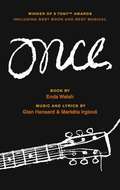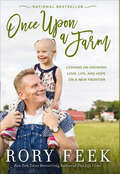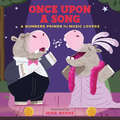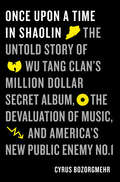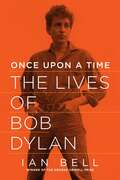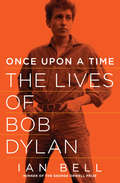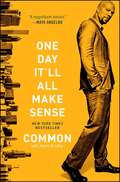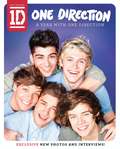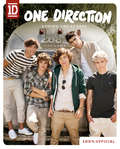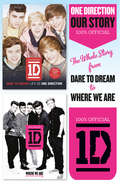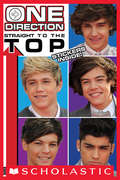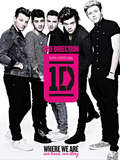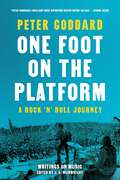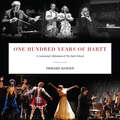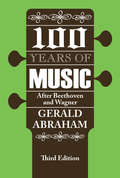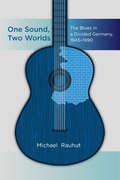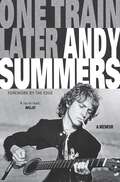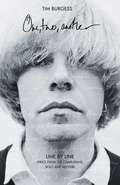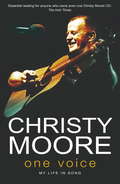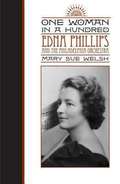- Table View
- List View
Once
by Enda Walsh Glen Hansard Markéta Irglová"A jewel box of a musical: small, delicate, brimming with emotion and charm."-Vogue"It may sound like heresy to fans of the 2006 film, but this bewitching stage adaptation arguably improves on the movie, expanding its emotional breadth and elevating it stylistically while remaining true to the original's raw fragility."?Hollywood ReporterRetaining the film's popular music and lyrics, acclaimed Irish playwright Enda Walsh adapts this charming tale of a complicated romance between an Irish street musician and a young Czech immigrant for the stage. A hit musical Off-Broadway, Once premiered on Broadway in spring 2012 to rave reviews.Enda Walsh is the author of five Edinburgh Festival Fringe First Award-winning plays, including Penelope, The Walworth Farce, and The New Electric Ballroom. He also co-wrote the film Hunger, which won the Camera d'Or award at the Cannes Film Festival.Glen Hansard and Markéta Irglová are the stars and songwriters of the 2006 film Once, for which they won an Academy Award for Best Song. The two comprise the musical folk-rock duo The Swell Season, which is currently touring the United States. A documentary film of the duo, The Swell Season, was an official selection of the 2011 Tribeca Film Festival. Hansard is also a member of the Irish band The Frames and Irglová is a classically trained Czech pianist and vocalist.
Once Upon a Farm: Lessons on Growing Love, Life, and Hope on a New Frontier
by Rory FeekNational BestsellerSometimes it&’s not only what we plant but where we&’re planted.Now raising their four-year-old daughter, Indiana, alone, after Joey&’s passing, Rory Feek digs deeper into the soil of his life and the unusual choices he and his wife, Joey, made together and the ones he&’s making now to lead his family into the future. When Rory Feek and his older daughters moved into a run-down farmhouse almost twenty years ago, he had no idea of the almost fairy-tale love story that was going to unfold on that small piece of Tennessee land . . . and the lessons he and his family would learn along the way.Now two years after Joey&’s passing, as Rory takes their four-year-old daughter Indiana&’s hand and walks forward into an unknown future, he takes readers on his incredible journey from heartbreak to hope and, ultimately, the kind of healing that comes only through faith.A raw and vulnerable look deeper into Rory&’s heart, Once Upon a Farm is filled with powerful stories of love, life, and hope and the insights that one extraordinary, ordinary man in bib overalls has gleamed along the way.As opposed to homesteading, this is instead a book on lifesteading as Rory learns to cultivate faith, love, and fatherhood on a small farm while doing everything, at times, but farming. With frequent stories of his and Joey&’s years together, and how those guide his life today, Rory unpacks just what it means to be open to new experiences.&“This isn&’t a how-to book; it&’s more of a how we, or more accurately, how He, God, planted us on a few acres of land and grew something bigger than Joey or I could have ever imagined.&”
Once Upon a Song: A Numbers Primer for Music Lovers
by Mike ByrneThis whimsical numbers board book shares a little music history while teaching your children the numbers 1 through 10.Toddlers learning to identify numbers will love this charming and funny book, while music-savvy parents will enjoy the artistic representation of some of their favorite song titles from some of their favorite musical artists.The book includes the following song titles:- ONE Fine Day (The Chiffons)- It Takes TWO (Rob Base & DJ EZ Rock)- THREE Little Birds (Bob Marley)- FOUR Strong Winds (Neil Young)- High FIVE (Beck)- SIX Weeks (James Morrison)- SEVEN SEAS OF RHYE (Queen)- EIGHT Days a Week (The Beatles)- Love Potion No. 9 (The Clovers)- TEN Feet Tall (Various)A follow-up to Running Press Kids's Somewhere Over the Rainbow: Colors in Music, this will be an ideal gift for the music-loving kid or family.
Once Upon a Time in Shaolin: The Untold Story of Wu-Tang Clan's Million-Dollar Secret Album, the Devaluation of Music, and America's New Public Enemy No. 1
by Cyrus BozorgmehrThe untold story of the world's most controversial album---a surreal tale of secret recordings, the Wu-Tang Clan, baffled customs agents, the world's most hallowed art institutions, and a villain of comic book proportions: Martin Shkreli.In 2007, the innovative young Wu-Tang producer, Cilvaringz, took an incendiary idea to his mentor the RZA. They felt that the impact of digitization threatened the sustainability of the record industry and independent artists, while shifting the perception of music from treasured works of art to disposable consumer products. Together they conceived a statement so radical that it would unleash a torrent of global debate---a sole copy of an album in physical form, encased in gleaming silver and sold through an auction house for millions as a work of contemporary art.The execution of this plan raised a number of complex questions: Would selling an album for millions be the ultimate betrayal of music? How would fans react to an album that's sold on the condition that it could not be commercialized? And could anyone ever justify the selling of the album to the infamous Martin Shkreli?As headlines flashed across the globe, the mystery only deepened. Opinions were sharply divided over whether this was high art or hucksterism---quixotic idealism or a cynical cash grab. Was it a noble act of protest, an act of cultural vandalism, an obscene symbol of greed, a subversive masterpiece, a profound mirror for our time, or a joker on capitalism's card table? As senior adviser to the project, Cyrus Bozorgmehr is uniquely placed to unlock the secrets behind the album and tell the full, unadulterated story. With explosive revelations about backroom plans made public for the first time, Once Upon a Time in Shaolin charts the album's journey from inception to disruption in vivid style.An extraordinary adventure that veers between outlandish caper and urgent cultural analysis. Once Upon a Time in Shaolin twists and turns through the mayhem and the mischief, while asking profound questions about our relationship with art, music, technology, and ultimately ourselves.
Once Upon a Time: The Lives Of Bob Dylan
by Ian BellHalf a century ago a youth appeared from the American hinterland and began a cultural revolution. The world is still coming to terms with what he did. How he did it—and why—has never fully been explored. In Once Upon a Time, award-winning writer Ian Bell draws together the tangled strands of the many lives of Bob Dylan in all their contradictory brilliance. For the first time, the laureate of modern America is set in his entire context: musical, historical, literary, political, and personal.Full of new insights into the legendary singer, his songs, his life and his era, this new biography reveals the artist who invented himself in order to reinvent America. Once Upon a Time is a study of a personality that has splintered and reformed, time after time, in a country forever struggling to understand itself. Dylan has become the mystery that illuminates. Here, in the first part of a major two-volume work, the mystery is explained.
Once Upon a Time: The Lives of Bob Dylan
by Ian BellHalf a century ago, a youth appeared from the American hinterland and began a cultural revolution. The world is still coming to terms with what Bob Dylan accomplished in his artistic explosion upon popular culture.In Once Upon A Time, award-winning author Ian Bell draws together the tangled strands of the many lives of Bob Dylan in all their contradictory brilliance. For the first time, the laureate of modern America is set in his entire context: musical, historical, literary, political, and personal.Full of new insights into the legendary singer, his songs, his life, and his era, the artist who invented himself in order to reinvent America is discovered anew. Once Upon A Time is a lively investigation of a mysterious personality that has splintered and reformed, time after time, in a country forever trying to understand itself. Now that mystery is explained.
One Day It'll All Make Sense
by Adam Bradley CommonFrom the hip hop icon, Hollywood star, and "a true artist and writer of deep talent" (James McBride, author of The Color of Water)--a candid, New York Times bestselling memoir ranging from his childhood on Chicago's South side and his emergence as one of rap's biggest names.Common has earned a reputation in the hip-hop world as a conscious artist by embracing themes of love and struggle in his songs. His journey toward understanding is rooted in his relationship with a remarkable woman, his mother. Common holds nothing back in this gripping memoir, both provocative and funny. He tells what it was like for a boy with big dreams growing up on the South Side of Chicago. He reveals how he almost quit rapping after his first album sold only two thousand copies. He recounts his rise to stardom and talks about the challenges of balancing fame, love, and family. Through it all, Common emerges as a man in full. Rapper. Actor. Activist. But also father, son, and friend. His story offers a living example of how, no matter what you've gone through, one day it'll all make sense.
One Day It'll All Make Sense
by Adam Bradley CommonCommon has earned a reputation in the hip hop world as a conscious artist by embracing themes of love and struggle in his songs, and by sharing his own search for knowledge with his listeners. His journey toward understanding--expressed in his music and now in his roles in film and television--is rooted in his relationship with a remarkable woman, his mother, Mahalia Ann Hines.In One Day It'll All Make Sense, Common holds nothing back. He tells what it was like for a boy with big dreams growing up on the South Side of Chicago. He reveals how he almost quit rapping after his first album, Can I Borrow a Dollar?, sold only two thousand copies. He recounts his rise to stardom, giving a behind-the-scenes look into the recording studios, concerts, movie sets, and after-parties of a hip-hop celebrity and movie star. He reflects on his controversial invitation to perform at the White House, a story that grabbed international headlines. And he talks about the challenges of balancing fame, love, and fatherhood. One Day It'll All Make Sense is a gripping memoir, both provocative and funny. Common shares never-before-told stories about his encounters with everyone from Tupac to Biggie, Ice Cube to Lauryn Hill, Barack Obama to Nelson Mandela. Drawing upon his own lyrics for inspiration, he invites the reader to go behind the spotlight to see him as he really is--not just as Common but as Lonnie Rashid Lynn. Each chapter begins with a letter from Common addressed to an important person in his life--from his daughter to his close friend and collaborator Kanye West, from his former love Erykah Badu to you, the reader. Through it all, Common emerges as a man in full. Rapper. Actor. Activist. But also father, son, and friend. Common's story offers a living example of how, no matter what you've gone through, one day it'll all make sense.ng example of how One Day -no matter what you've gone through--It'll All Make Sense.Rashid Lynn, aka, Common, a film and television actor and award-winning music artist, lives in Los Angeles. An independent publisher/author of books for children, including The Mirror and Me and I Like You but I Love Me, this is his first book for adults.
One Direction: A Year with One Direction
by One DirectionOne Direction are the biggest band on the planet. Celebrate their story with this official guide crammed full of exclusive interviews and never-seen-before photos.
One Direction: Behind the Scenes
by One DirectionPacked with never-before-seen photos, exclusive interviews, and fascinating facts, you'll find everything you ever needed to know about Harry, Niall, Liam, Louis, and Zayn inside! A must-have for every One Direction fan! One Direction are: Harry Styles, 19; Liam Payne, 20; Louis Tomlinson, 21; Niall Horan, 19; and Zayn Malik, 20. The band was formed in the X Factor's Boot Camp stage in 2010 and left the competition in its final round. They went on to break several records, top the charts internationally, and sell over 20 million records worldwide.
One Direction: Dare to Dream
by One DirectionIt's hard to believe how much has changed for us in just a few months. From five guys who didn't even know each other to making it to The X Factor final, heading off on our first tour, recording our first album, and releasing our own music, we've written this book so you can get to know who we really are, where we came from, and where we're going next. This is our story of life as One Direction so far, and we're really proud to share it all with you! "It's no exaggeration to say we're having the time of our lives right now, and it would not be happening if it wasn't for you. Thank you for all your unbelievable support."
One Direction: Meet One Direction
by One DirectionThe only 100% fully official annual--written in collaboration with One Direction. This is the annual for all 1D fans! Find out straight from Harry, Liam, Louis, Niall, and Zayn what they think about success, their musical influences, the making of their movie, their style, their amazing fans, and much more! With exclusive interviews, up-to-the-minute news, and fantastic never-before-seen photos, this is a must-have for all One Direction fans and a fantastic gift for any occasion!
One Direction: Our Story
by One DirectionWhere We Are, the hotly anticipated official 1D book, is now combined for the first time in a single ebook volume with One Direction's first-ever official book, Dare to Dream. One Direction: Our Story: The Whole Story from Dare to Dream to Where We Are charts the boys' full story in their own words, from The X Factor to global superstardom, their own movie, and a 133-date tour. A must-have for all fans that missed out on Dare to Dream the first time around. Includes never-before-seen images exclusive to this ebook. Packed with exclusive beautiful photos, backstage snapshots, hand-written annotations, and brand-new insights into the boys' world, Where We Are is a unique book charting the boys' thoughts and feelings, hopes and dreams, and highs and lows of the last year that no fan's life is complete without—bringing the 1D story right up to date.
One Direction: Straight to the Top!
by Riley BrooksMove over Bieber, there's a new pop sensation in town!The next hot band is here, and it's One Direction! These five super cute boys from the UK have a #1 debut album, sold-out tours, famous friends, and tons of fans. And they're only heading in one direction--up! Check out this awesome book full of fun facts and pictures to find out more about 1D!
One Direction: Where We Are
by One DirectionCalling all One Direction fans This is the only official book from 1D charting their journey over the last year and a half--from the places theyve visited and fans theyve met, to their thoughts and feelings, hopes and dreams, highs and lows. It has been a phenomenal year--and this is a phenomenal story. This Christmas, there will be no other book that true One Direction fans will want
One Foot on the Platform: A Rock 'N' Roll Journey
by Peter GoddardThe final word from one of popular music's greatest critics. In the summer of 2020, acclaimed music critic and journalist Peter Goddard began work on a new book that would take readers on a journey back through his fifty-plus years spent writing professionally about rock music and the musical styles circling it—everything from blues and jazz to country and classical. His plan was to revisit his old haunts and their habitués, scenes and figures he first wrote about starting in the mid-1960s when he became Canada’s first on-staff popular music critic, to show how ongoing revisions continually reframe first impressions. Tragically, Goddard died in 2022 before work on the manuscript was complete. But many of the core essays—on Bob Dylan, John Lennon and Yoko Ono, the Who, k.d. lang, David Bowie, Liza Minelli, The Band, Neil Diamond, and others—are here. Accompanying these new essays is a collection of some of the best writing of Goddard’s career—ranging from interviews with B. B. King, Joni Mitchell, Paul Simon, Bruce Springsteen, and Janis Joplin to reviews of classic albums by the Beatles, the Rolling Stones, and Neil Young, to close readings of Leonard Cohen, Anne Murray, Led Zeppelin, and Gordon Lightfoot. Taken as a whole, One Foot on the Platform represents more than fifty years of thought and writing by one of Canada’s foremost cultural critics.
One Hundred Years of Hartt: A Centennial Celebration of The Hartt School (Hartford)
by Demaris HansenThe University of Hartford's Hartt School celebrates its centennial in this lavishly illustrated book. The Hartt School holds unique qualities that continue to distinguish it from other performing arts institutions. Through personal and official written communications, school newsletters, speeches, and the exquisite quality of artistic expression, a belief in the value of art is continually reinforced, often with great eloquence, sometimes with humor, and always from the heart.
One Hundred Years of Music: After Beethoven and Wagner
by Gerald AbrahamOne Hundred Years of Music provides a full account of the history of music from the death of Beethoven to the modern era. It covers a period of exceptional interest. The last hundred years coincide roughly with the rise and decline of Romanticism, include the various nationalist movements, and extend to the advent of "neo-classicism," the twelve-tone system, and still more modern techniques. Abraham devotes ample space to modernist and avant garde music, in which he explains the difficulties we experience in listening to the work of such composers as Schnberg, Bart k, and Berg. He also throws new light on many more familiar topics.In its earlier editions, One Hundred Years of Music became a standard work on this subject; it has since been brought updated to include coverage of later developments. Abraham approaches his subject as an historian of style rather than an esthetic critic. Rather than pass judgment on particular works or composers, he shows how music has developed, and thus provides a clear and connected history that is more substantial than most books of musical appreciation. An extensive chronology and a full bibliography and index add to the usefulness of the book for students, professionals and musical laymen alike.This third edition incorporates some corrections of fact, further enlarges the bibliography and chronology, and adds commentary on developments in music techniques. In order to correct the historical perspective, the author has included a "prelude" and three "interludes," giving rough sketches of general conditions in the musical world at intervals of thirty years. As the reader's sense of chronology is very apt to get confused when a number of simultaneous streams of development have to be described, the author has inserted the date of composition or performance (both if they are widely separated) of each work at the first mention of it.
One Sound, Two Worlds: The Blues in a Divided Germany, 1945-1990
by Michael RauhutFor all of its apparent simplicity—a few chords, twelve bars, and a supposedly straightforward American character—blues music is a complex phenomenon with cultural significance that has varied greatly across different historical contexts. One Sound, Two Worlds examines the development of the blues in East and West Germany, demonstrating the multiple ways social and political conditions can shape the meaning of music. Based on new archival research and conversations with key figures, this comparative study provides a cultural, historical, and musicological account of the blues and the impact of the genre not only in the two Germanys, but also in debates about the history of globalization.
One Train Later: A memoir
by Andy SummersFrom his first guitar at age 13 and his early days on the Bournemouth music scene, to his relationships and encounters in London and the US with Zoot Money's Big Roll Band, Jimi Hendrix, Eric Clapton, John Belushi and Eric Burdon, among others, Andy Summers proves himself a master of telling detail and dramatic anecdote. But, of course, the early work is only part of the story, and Andy's account of his role as guitarist for The Police - a gig he almost didn't get, despite the wishes of bassist/singer Sting, until a chance encounter with drummer Stewart Copeland on a London train - is the first full inside story of the band ever published. The heights of fame that The Police achieved have rarely been duplicated, and they were rivaled only by the personal chaos that such success brought about, an insight never lost on Summers in the telling. With never-before-published photos from Summers' personal collection, One Train Later is a constantly surprising and poignant memoir, and the work of a first-class writer.
One Two Another: Line By Line: Lyrics from The Charlatans, Solo and Beyond
by Tim BurgessA Rough Trade Book of the Year 'From lists to experiences and stories, there are no rules. A good song is a good song whoever writes it and however the writing happens.'Tim Burgess is a musical maverick and legend. Over the past three decades, he has cultivated a lyrical style that is equal parts searing, elusive and raw. Brimming with nods to an eclectic array of influences, from French chanson to East Coast rap, his words provide vivid snapshots of modern life, its highs and lows, and the things we do to get by.For the first time Tim's collected lyrics are accompanied by his revealing commentary, featuring backstage anecdotes, advice on how to conjure up the music muse, poignant reflections - and insight into a very idiosyncratic songwriting process.One Two Another chronicles the evolution of Tim's songwriting and reveals the method behind the madness.'Tim Burgess is a crusader and vinyl's epic voyager. He knows why pop's art, a culture and a cure. Learn and listen. He knows good things' Johnny Marr'You can't feel blue around Tim. He makes you feel happy, not just about music but about life. Even the most cynical of souls (mine) become infected by his gorgeous energy. Plus he gives good vinyl' Sharon Horgan
One Two Another: Line By Line: Lyrics from The Charlatans, Solo and Beyond
by Tim BurgessA Rough Trade Book of the Year 'From lists to experiences and stories, there are no rules. A good song is a good song whoever writes it and however the writing happens.'Over the past three decades, Tim Burgess has cultivated a lyrical style that is equal parts searing, elusive and raw. Brimming with nods to an eclectic array of influences, from French chanson to East Coast rap, his words provide vivid snapshots of modern life, its highs and lows, and the things we do to get by.For the first time Tim's collected lyrics are accompanied by his revealing commentary, featuring backstage anecdotes, advice on how to conjure up the music muse, poignant reflections - and insight into a very idiosyncratic songwriting process.One Two Another chronicles the evolution of Tim's songwriting and reveals the method behind the madness.'Tim Burgess is a crusader and vinyl's epic voyager. He knows why pop's art, a culture and a cure. Learn and listen. He knows good things' Johnny Marr'You can't feel blue around Tim. He makes you feel happy, not just about music but about life. Even the most cynical of souls (mine) become infected by his gorgeous energy. Plus he gives good vinyl' Sharon Horgan
One Voice
by Christy MooreChristy Moore is in every sense Ireland's folk hero. Mentor to a whole generation of Irish musicians, he holds a unique place in musical history. In l992 he broke all attendance records during 12 packed nights at the Point in Dublin. In the UK he fills concert halls around the country. In l997 he announced that he was taking an extended break from touring and recording. It was headline news in Ireland. So was his comeback which began in l999. Set to be an enormous best-seller, his autobiography marries both songs and memories. Around 250 of his favourite lyrics are accompanied by his memories around the song itself and his life. Each entry is fresh, direct, honest and spontaneous - like the most intimate diary. Through it he charts his life from drunk to sober, bar-room guitar player to international singer-songwriter.
One Voice
by Christy MooreChristy Moore is in every sense Ireland's folk hero. Mentor to a whole generation of Irish musicians, he holds a unique place in musical history. In l992 he broke all attendance records during 12 packed nights at the Point in Dublin. In the UK he fills concert halls around the country. In l997 he announced that he was taking an extended break from touring and recording. It was headline news in Ireland. So was his comeback which began in l999. Set to be an enormous best-seller, his autobiography marries both songs and memories. Around 250 of his favourite lyrics are accompanied by his memories around the song itself and his life. Each entry is fresh, direct, honest and spontaneous - like the most intimate diary. Through it he charts his life from drunk to sober, bar-room guitar player to international singer-songwriter.
One Woman in a Hundred: Edna Phillips and the Philadelphia Orchestra (Music in American Life)
by Mary Sue WelshGifted harpist Edna Phillips (1907–2003) joined the Philadelphia Orchestra in 1930, becoming not only that ensemble's first female member but also the first woman to hold a principal position in a major American orchestra. Plucked from the Curtis Institute of Music in the midst of her studies, Phillips was only twenty-three years old when Leopold Stokowski, one of the twentieth century's most innovative and controversial conductors, named her principal harpist. This candid, colorful account traces Phillips's journey through the competitive realm of Philadelphia's virtuoso players, where she survived--and thrived--thanks to her undeniable talent, determination, and lively humor. Drawing on extensive interviews with Phillips, her family, and colleagues as well as archival sources, One Woman in a Hundred chronicles the training, aspirations, setbacks, and successes of this pioneering woman musician. Mary Sue Welsh recounts numerous insider stories of rehearsal and performance with Stokowski and other renowned conductors of the period such as Arturo Toscanini, Fritz Reiner, Otto Klemperer, Sir Thomas Beecham, and Eugene Ormandy. She also depicts Phillips's interactions with fellow performers, the orchestra management, and her teacher, the wily and brilliant Carlos Salzedo. Blessed with a nimble wit, Phillips navigated a plethora of challenges, ranging from false conductors' cues to the advances of the debonair Stokowski and others. She remained with the orchestra through some of its most exciting years from 1930 to 1946 and was instrumental in fostering harp performance, commissioning many significant contributions to the literature. This portrait of Phillips's exceptional tenure with the Philadelphia Orchestra also reveals the behind-the-scenes life of a famous orchestra during a period in which Rachmaninoff declared it "the finest orchestra the world has ever heard." Through Phillips's perceptive eyes, readers will watch as Stokowski melds his musicians into a marvelously flexible ensemble; world-class performers reach great heights and make embarrassing flubs; Greta Garbo comes to Philadelphia to observe her lover Leopold Stokowski at work; and the orchestra encounters the novel experience of recording for Walt Disney's Fantasia. A colorful glimpse into a world-class orchestra at the height of its glory, One Woman in a Hundred tells the fascinating story of one woman brave enough and strong enough to overcome historic barriers and pursue her dreams.
